Paul Hollywood’s sourdough starter recipe uses grapes to create a simple sourdough starter, the base for all your sourdough needs. This post covers everything you need to know about sourdough starter and how to keep your starter alive and happy.
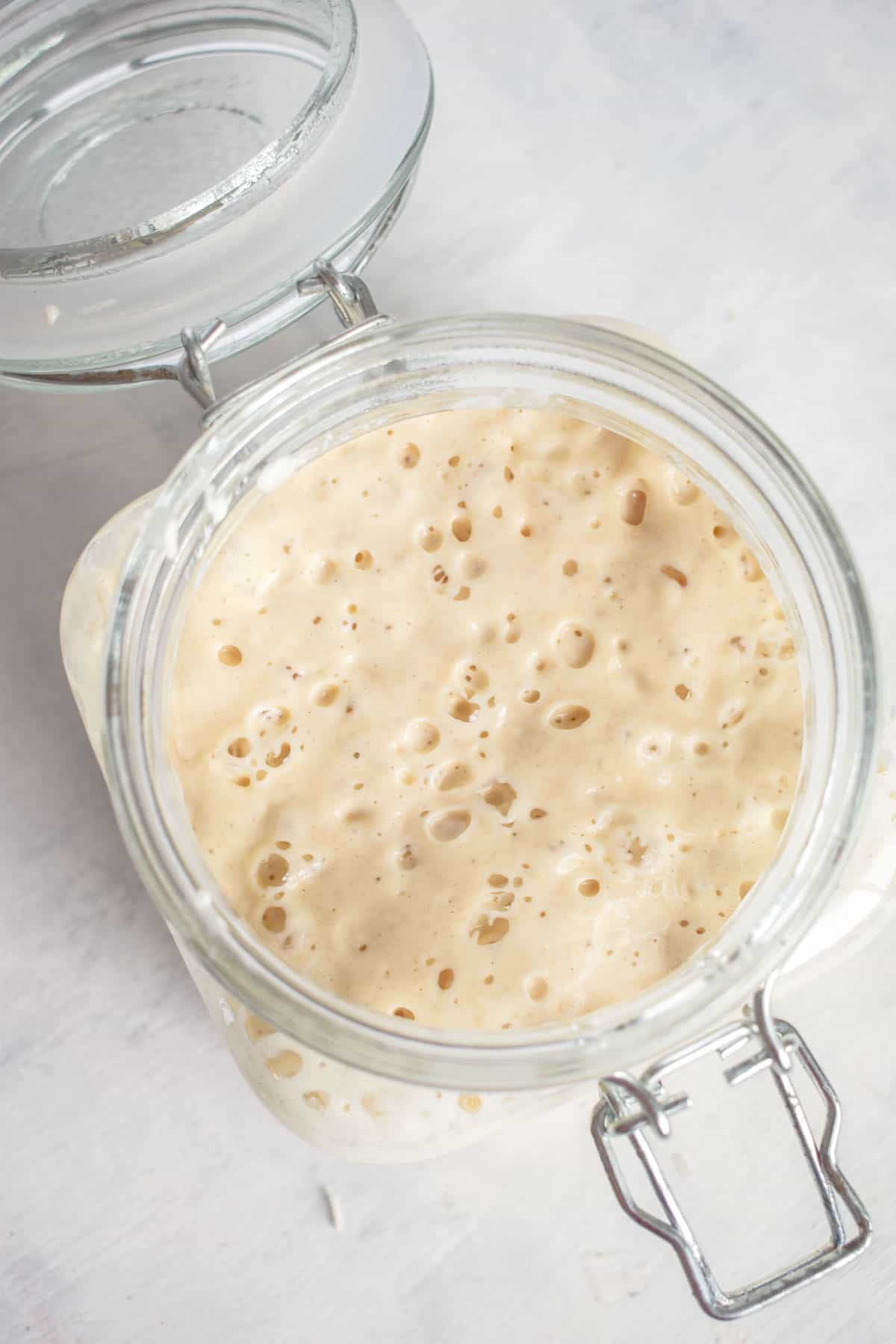
Why This Recipe Works
This recipe is straight from the bread king himself, Paul Hollywood. His recipes uses 100% hydration to make and feed this classic recipe. We also take the time to explain the basics of sourdough and cover any problems you may encounter on your sourdough journey.
What is sourdough starter?
Sourdough starter is a mixture of flour and water that are allowed to ferment and create bacteria cultures and wild yeast. Sourdough starter adds a distinct sour flavor to your bread but also leavens (makes it rise) the bread. The wild yeast produced by the fermentation of flour and water give off carbon dioxide, making the bread rise and contributing to the structure of the bread.
Ingredient Notes
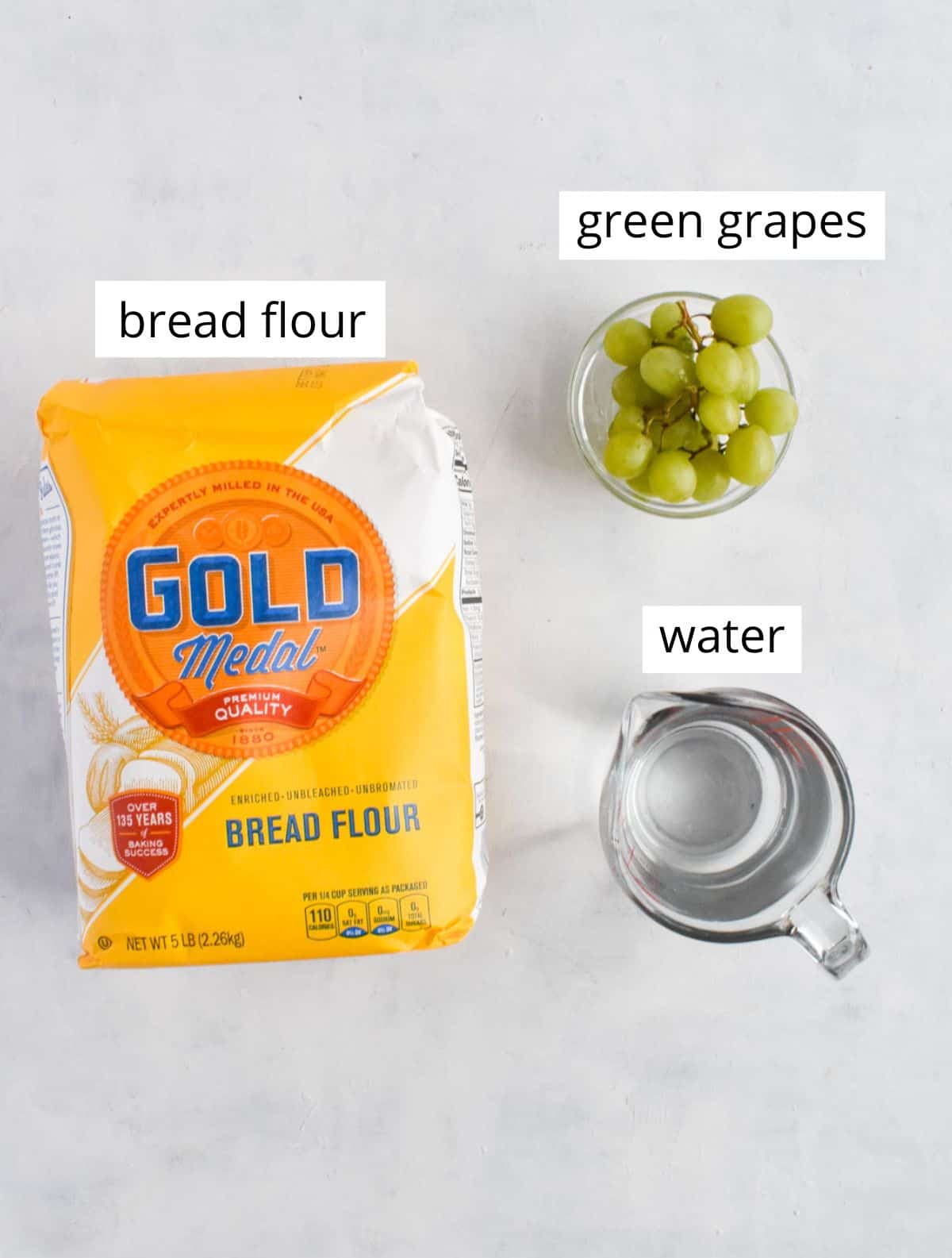
- Bread Flour. Bread flour has a higher protein content which will give you a stronger and more reliable starter.
- Water. Impurities and minerals in water can sometimes affect your starter. If you have filtered water, I recommend using it.
- Grapes. Green seedless grapes will give your starter an extra push to get started. Organic grapes are best so there are no chemicals that can affect your sourdough starter.
How to Make Sourdough Starter
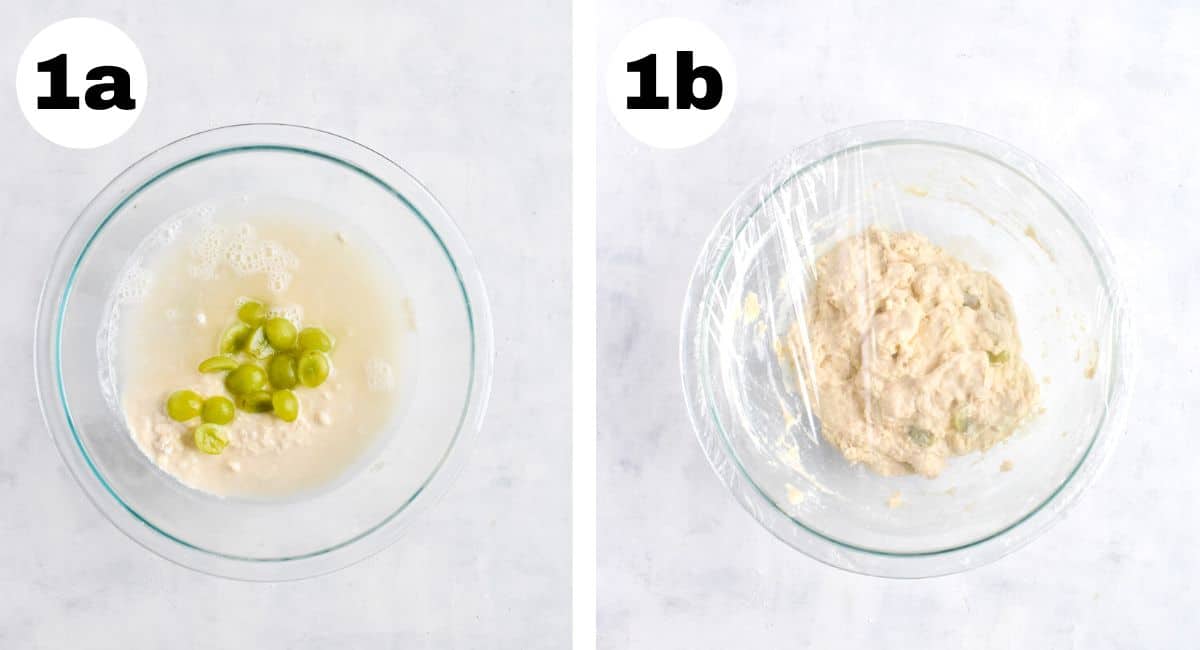
- Day 1. Slice your grapes in half and combine with flour and lukewarm water. Place in a large container so there is plenty of room for the mixture to grow. Cover it so the starter does not dry out.
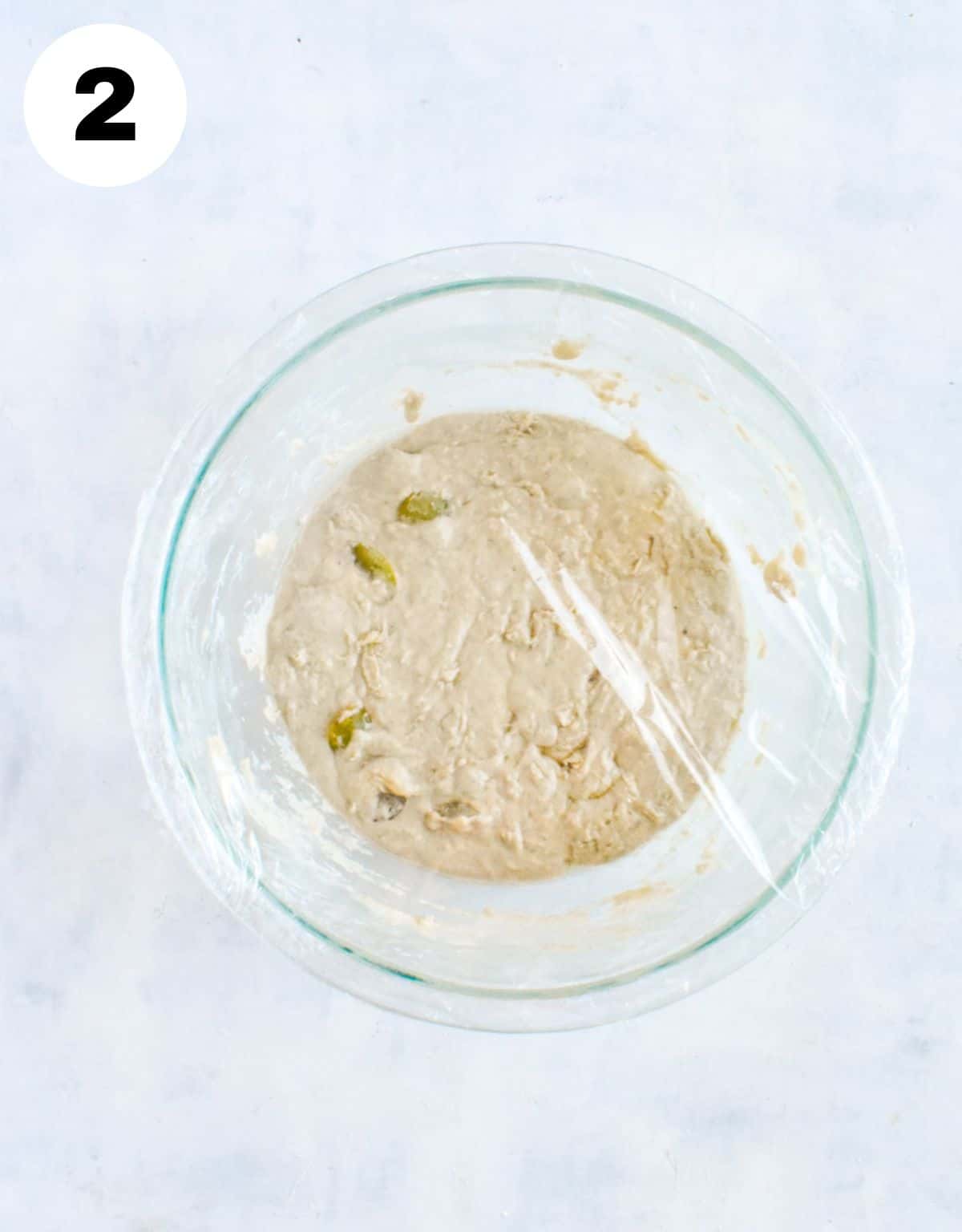
- Day 2. Do nothing, let the mixture keep fermenting.
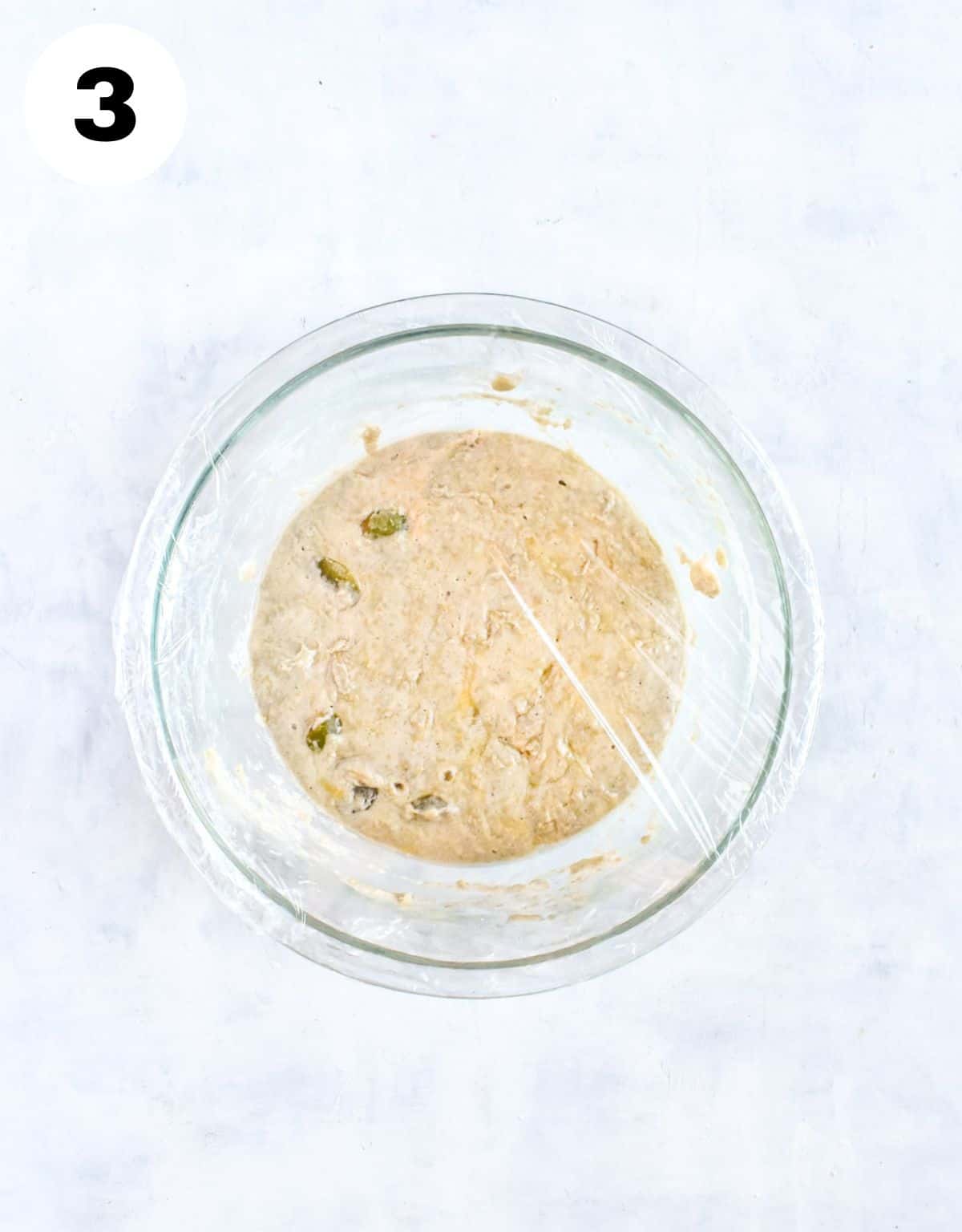
- Day 3. Do nothing. Keep letting it do its thing and develop.
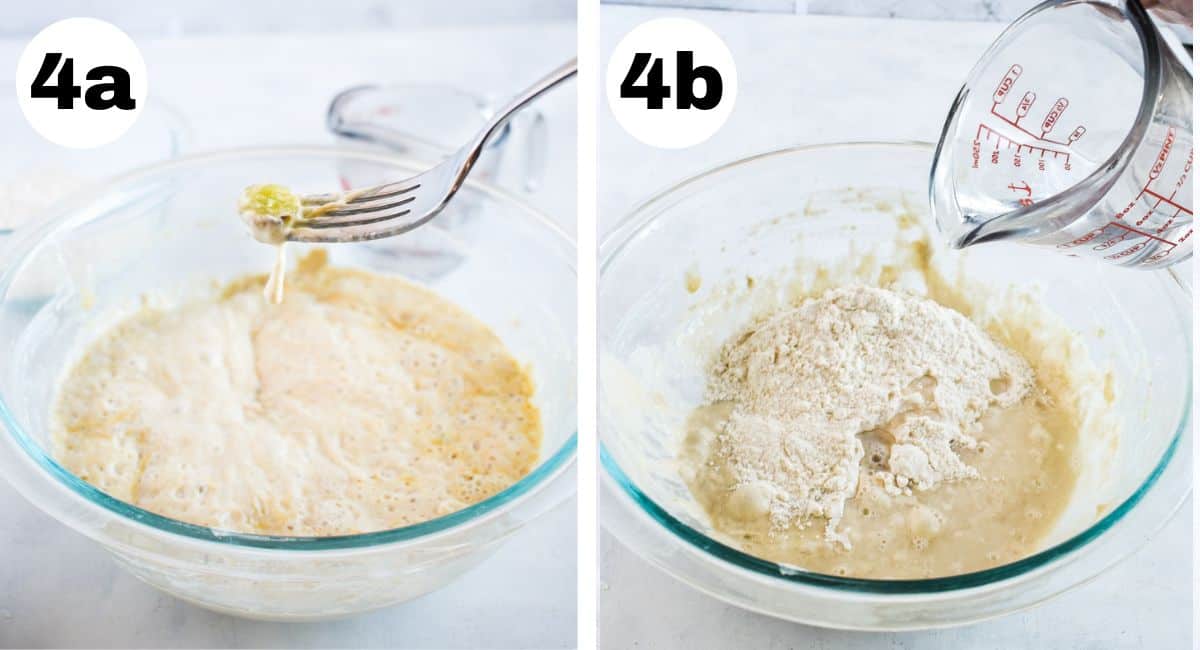
- Day 4. Remove the grapes and discard half of the mixture. Do your first “feed” and add flour and water listed under “Ingredients for Feeding.” Let develop for another 24 hours before the starter is ready to use.
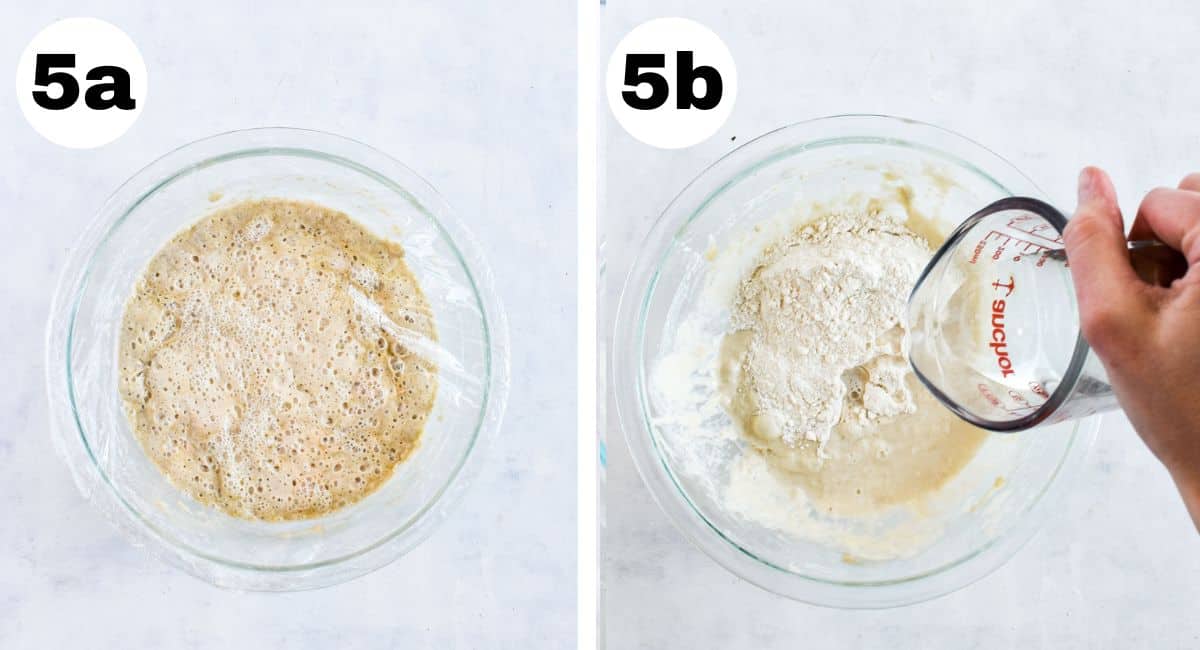
- Discard and Refeed. Discard half of your starter and refeed your starter regularly to keep your starter active.
Hydration levels in Sourdough Bread
This sourdough starter is a 100% hydration starter. Hydration levels of bread are measured in percentages and can vary from 65% to 100%. Hydration levels can affect the pH levels of your starter and bread and can change the flavor profile (the distinct sour flavor) of the bread. Hydration levels also affect your bread’s texture. The higher the hydration level the more open, rugged crumb texture and crispier crust you get.
One hundred percent hydration means that the starter or bread use a 1:1 ratio of flour and water. The ratio is measured in grams, so 1 gram of water to 1 gram or flour. Or if you are using volume as your measurement, then it is a 1:2 ratio of water to flour.
Example: If we are feeding the starter 100 grams of flour at 100% hydration then you will feed it 100 grams of water as well. If you are feeding the starter 100 grams of flour at 50% hydration you will feed it 50 grams of water instead of 100.
If using volume, remember we are using a 2:1 ratio. So, if you are feeding your starter 1 cup of flour at 100% hydration you will use ½ cup of water.
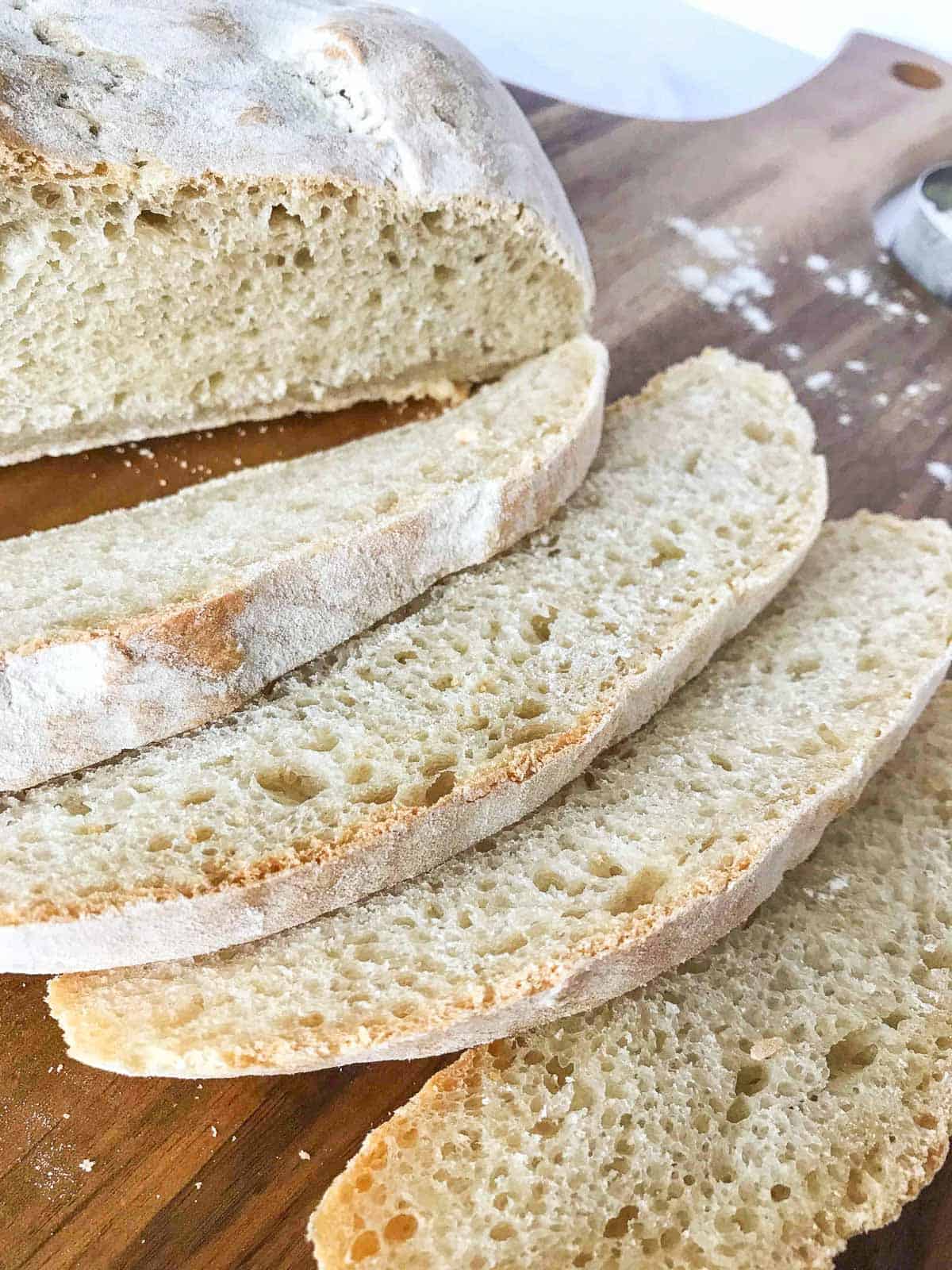
What Kind of Flour to Use?
Paul Hollywood suggests using bread flour to cultivate your starter. Once your starter is mature and reliable you can switch to all-purpose flour if you prefer.
Paul Hollywood also says that if your starter is weak you can strengthen it by feeding it rye flour.
How to feed and Maintain Sourdough Starter
To keep your starter active and happy you’ll need to take a portion of your starter and feed it a with flour and water. The good bacteria in the starter needs to eat the sugar and starches in the flour to stay active and prevent “hooch” (naturally occurring alcohol) or bad bacteria from forming.
You need to discard some of your starter so you don’t get an excessive amount of starter. Remember it’s all about proportions when you feed it, the more starter you have the more you have to feed it.
When you are first starting out with your starter it is ideal to feed it every 12-24 hours until your starter becomes predictable and mature. The longer you maintain your sourdough starter the more mature and resilient it becomes. Once mature, your starter will be easy to feed once a week or refrigerate to revive at a later time.
Feeding Ratio
To feed your starter you’ll want to do it based on weight. You’ll do one part starter to one part water and one part flour. For example, If you are feeding 100 grams of starter you’ll feed it 100 grams of flour and 100 grams of water.
For volume, this recipe calls for feeding your starter ¾ cup + 1 tablespoon flour and 7 tablespoons lukewarm water. Or, you’ll do about 1 part starter, to 1 part water, to 2 parts flour.
You starter will need 4-12 hours to eat through the starches and sugars in the flour to become active again. Meaning, once fed, your starter will not be active and ready to use for 4-12 hours.
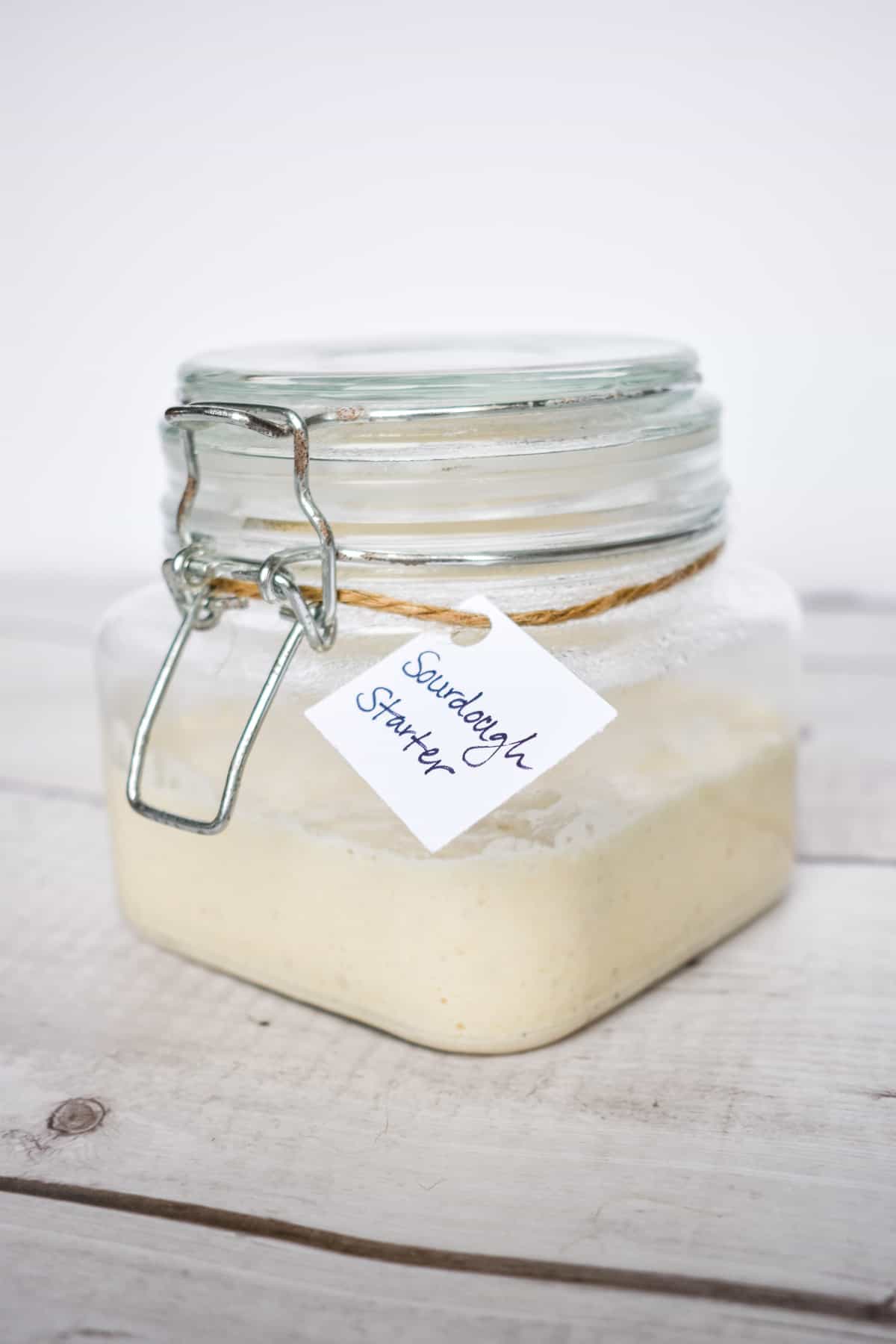
Sourdough Starter Consistency
Paul Hollywood says this on sourdough starter consistency, “If you shake it, it should wobble like a jelly, without dropping down. When you put a spoon through it, it should be like a thick batter.”
If you have a liquidy sourdough starter you are either underfeeding (feed it in a higher ratio of flour and water to starter) or you are not feeding it often it enough.
How Often Do You Need to Feed Your Starter?
Sourdough starter is a living organism. Think of it as a pet, It needs to be fed regularly to be happy and active. When you are first starting off cultivating your starter it is ideal to feed it every 12-24 hours until it is steady, stable, predictable, and matured.
How to Tell if Your Starter is Active and Ready
One question I often get is how can I tell if my sourdough starter is active and ready? Within 12 hours of feeding your starter your starter should have doubled in size and have bubbles. This is your sign that it is ready to be baked with!
One trick I use to tell if my starter is growing is I’ll place a rubber band around my jar of starter, marking where the starter was when I fed it. This makes it super obvious if it is growing and active.
How to Store Sourdough Starter
Generally speaking, the your starter should be covered and stored at room temperature (between 70-78 degrees Fahrenheit). Once your sourdough starter has matured you can refrigerate it and feed it 1-2x a week or to store it long term you can freeze or dehydrate it.
How to Store Your Starter in Fridge and Feed Weekly
If you are not using your starter every day you can store it in the fridge and feed it once a week.
Before moving your starter to the refrigerator, feed it, place lid on or cover it and let sit at room temperature for 2-3 hours. Then place in the fridge.
Feed it Weekly
Let starter sit at room temperature for at least 30 minutes. Then take 100 grams of starter (a scant ½ cup) and mix it with 100 grams bread flour ( ¾ cup + 1 tablespoon) and 100 grams lukewarm water (7 tablespoons). Tip mixture back into its container and cover. Let it sit at room temperature for about 2 hours before returning to the fridge.
Get it Ready to Bake With
After removing the starter from the fridge follow the instruction above for feeding the starter, but do not return it to the refrigerator. Let it continue to rest and become active at room temperature. Your starter should become active within 12 hours. If it does not grow and become bubbly, feed the starter again.
Make sure you don’t discard all your starter if you are planning on baking soon! Leave enough starter for your recipe and then some to cultivate. Don’t forget to feed your starter before returning it to the fridge after you do your baking.
How to Store Sourdough Starter Long Term
If you’d like to take long bread from your starter without worry about it, I recommend freezing or dehydrating it! Or, if you’d like to have a backup starter in case you neglect your regular starter, this is a great solution!
How to Freeze Sourdough Starter
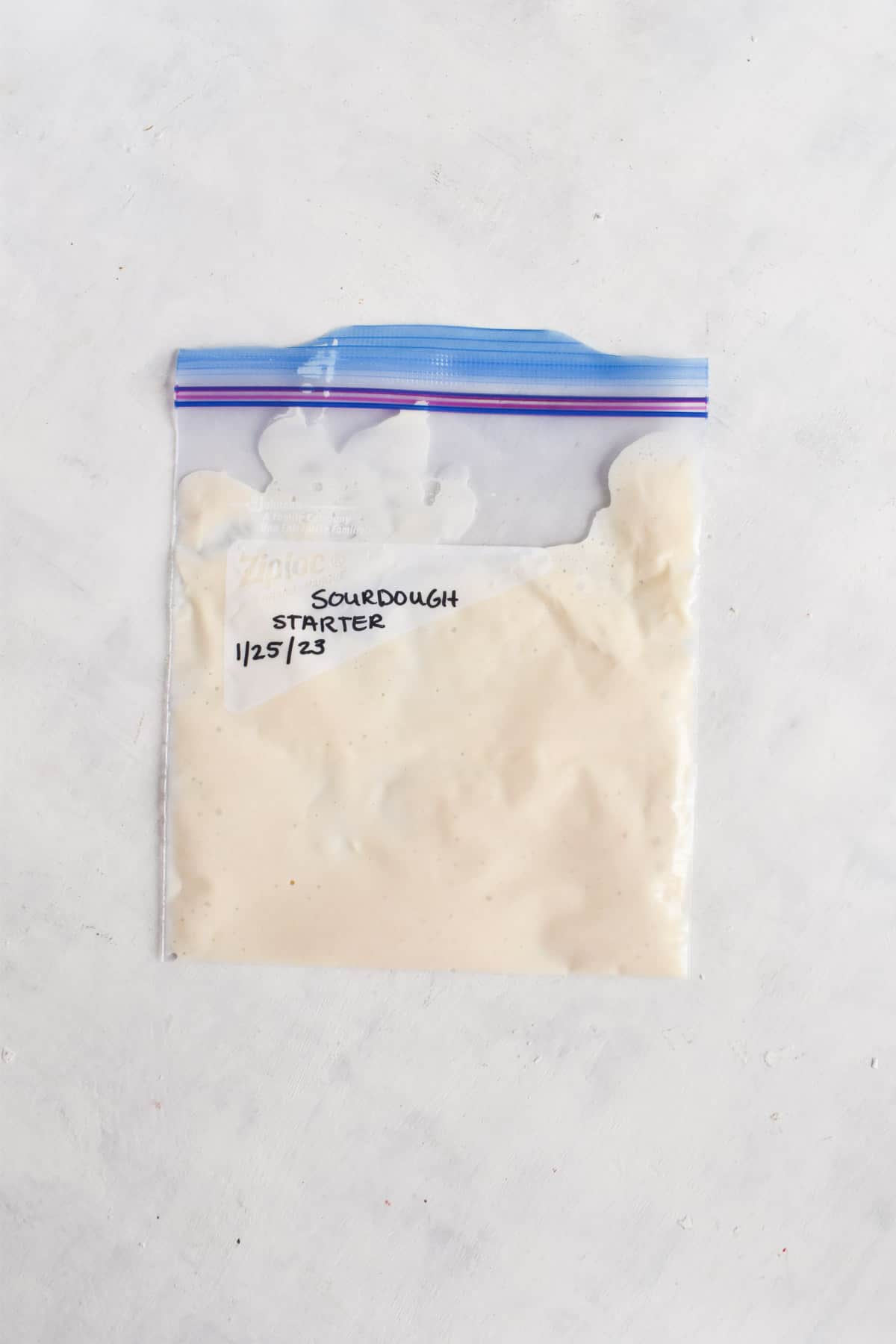
- Make sure you have fed your starter in the last 12 hours AND it is active and bubbling.
- Take ½-1 cup of starter and place it in a quart-sized freezer bag. Squeeze all the air out of the bag before sealing. I like to double bag it to help prevent it from freezer burning. Label and date it and store for up to 12 months.
- When you’re ready to use your sourdough starter, thaw it out completely (1-2 hours) and feed 50 grams of starter with 50 grams of water and 50 grams of flour. Feed every 24 hours until it is active and bubbly.
How to Dry or Dehydrate Sourdough Starter
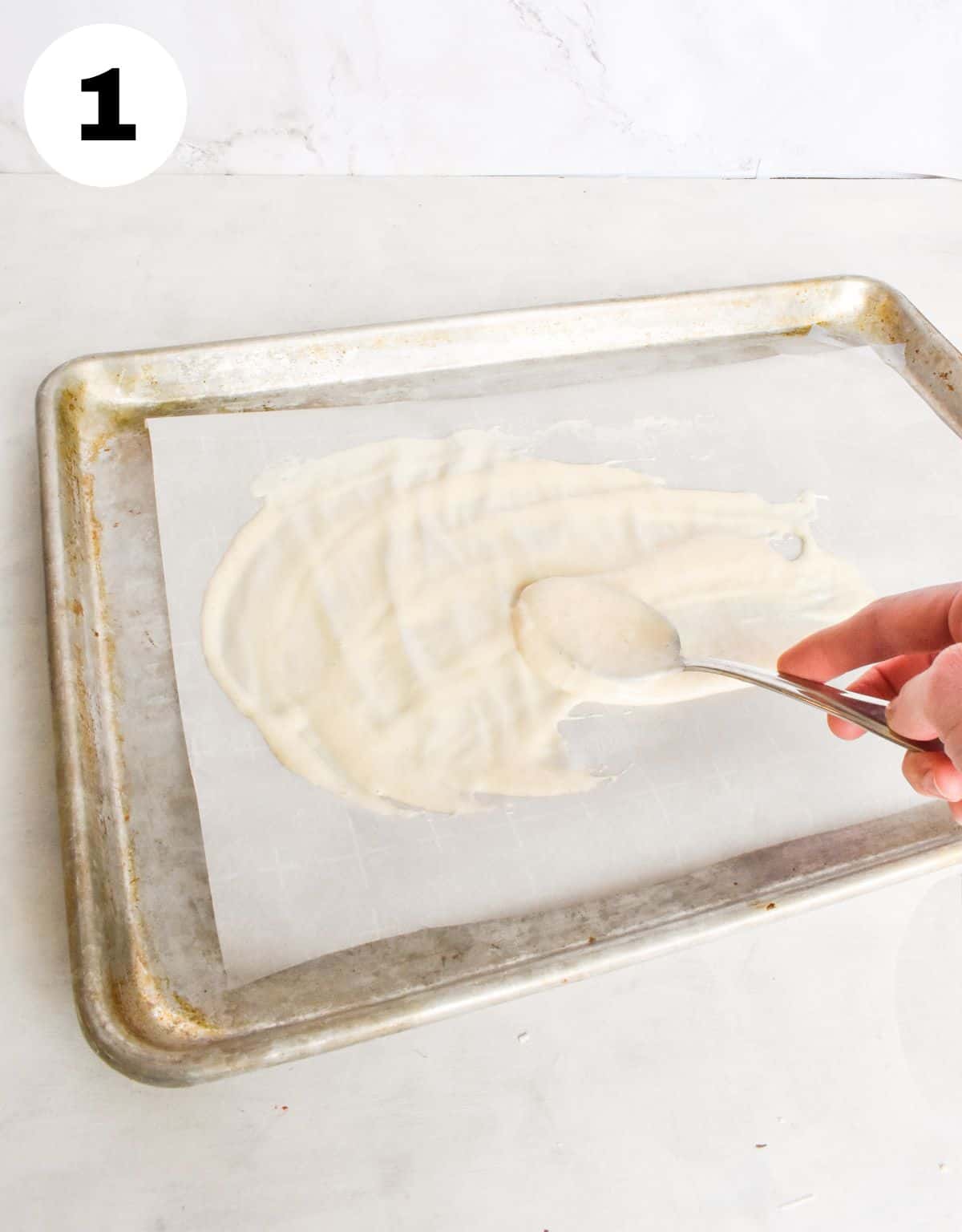
- Line a baking sheet with a silicone baking mat or a piece of parchment paper. Take a large spoonful of starter and spread thinly across the parchment paper.
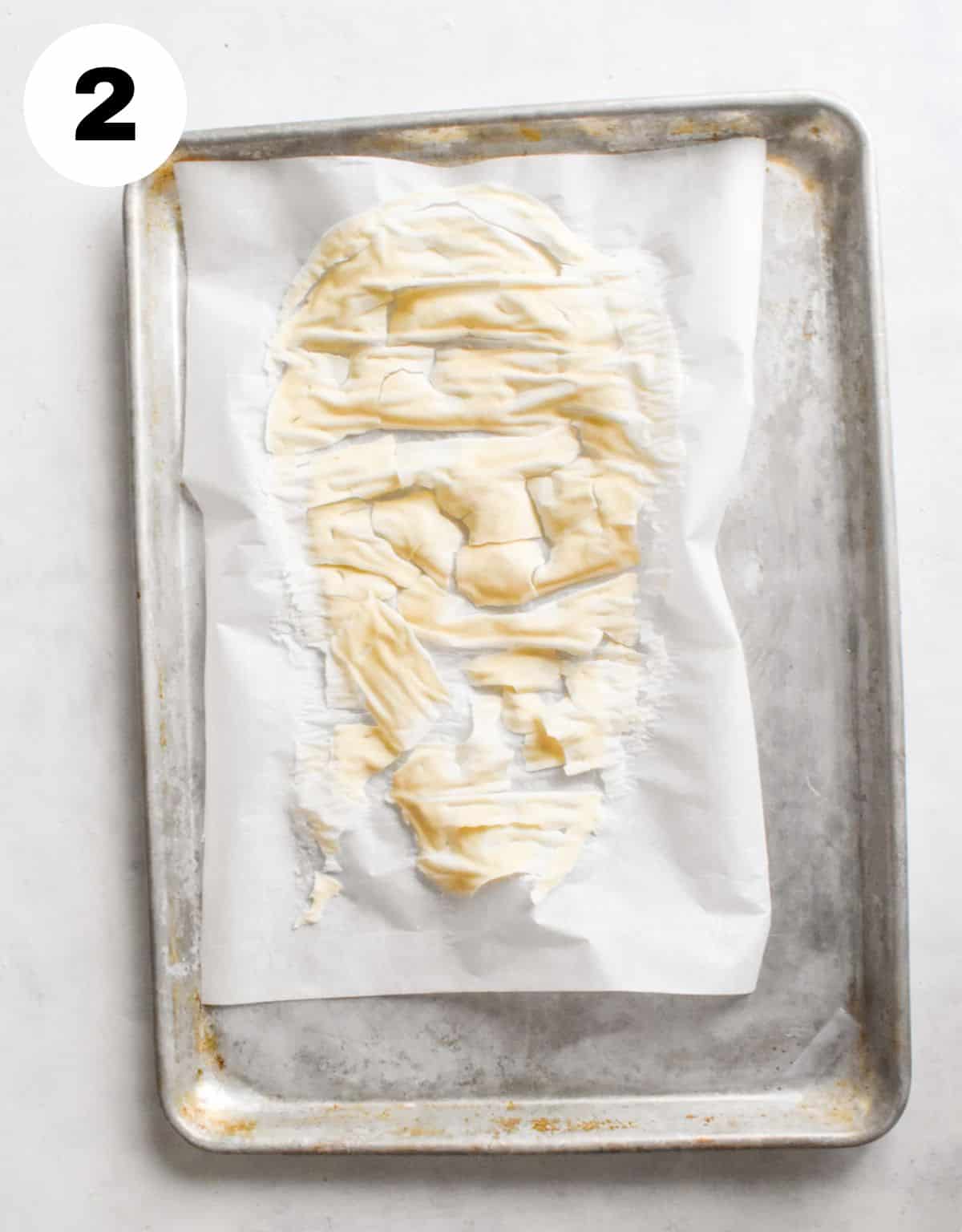
- Let it dry for 2-3 days. The mixture should be completely dry before you attempt to remove it from the paper.
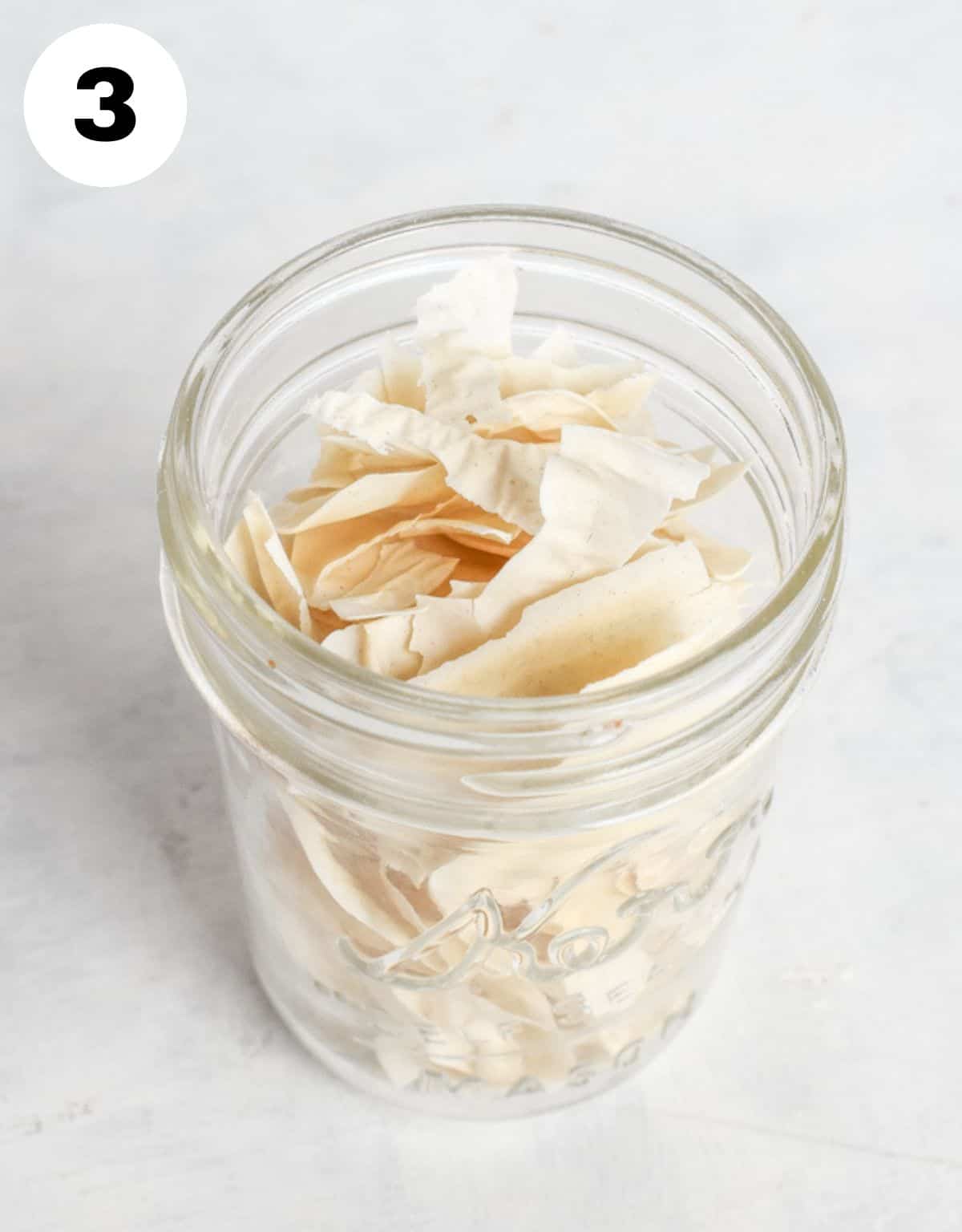
- Break the dried starter up into small chunks and store in a jar in the pantry or cupboard OR place in a freezer bag in the freezer. You should be able to store dried starter indefinitely.
- When you’re ready to use your dried sourdough starter, take 50 grams dried starter and mix it with 50 grams of warm water. Let mixture sit for 12-24 hours.
- Weigh 50 grams of your rehydrated starter and mix with 50 grams of water and 50 grams of flour. Let sit 24 hours, continue feeding your starter every 24 hours until bubbling and active.
How to Revive Your Sourdough Starter
Last year I let my sourdough starter go. I stuck it in my fridge and did not touch it for an entire year. That’s right, I did not feed it once in an entire year and here’s how I revived it! When I pulled the starter out of the fridge to attempt to revive it had a thick layer of black liquid on top and the starter itself was about the consistency of stiff play doh.
- Start by bringing your starter room temperature, it’ll take about 1-2 hours. Then, pour off any liquid on your starter and inspect it.
- Is it moldy? If it is moldy, scrap off any mold and discard it. Be sure to use a clean, mold-free spoon to remove part of the starter in the next step. If your liquid on top is pink-ish, it’s time to abandon your starter and start over.
- Feed it! Your starter is starving, so the first thing to do is feed it. Take 50 grams of starter and mix it with 50 grams of flour and 50 grams of lukewarm water. Mix together in a clean bowl and cover or tip into an airtight container. Let sit for 12 hours, ideally somewhere warm.
- If after 12 hours your starter is showing sign of activity (bubbles!) and if it has nearly doubled in size, go ahead and let it hang out for another 12 hours.
- If your starter isn’t seeing much or any activity after the first 12 hours, feed it again at the same ratio, 50 grams starter + 50 grams flour + 50 grams lukewarm water. If you home is cold, put it somewhere warm to help it reactivate it. Let sit for another 12 hours.
- If your starter has doubled in size and is bubbly, congratulations, you’ve revived it! Start feeding it every 24 hours for at least a week before you attempt to refrigerate it again.
- If your starter is still not showing any signs of life after the second feed, try feeding it one more time before abandoning it! If your starter bubbly, but has not doubled in size keep feeding it every 12 hours and keep it somewhere warm. I tried reviving mine in January and my house was cold! The starter wasn’t doing anything at all after 2 feeds, I placed mine a bathroom cabinet that gets super warm from a heat vent and 12 hours later I had bubbles!
How to Strengthen Sourdough Starter
If you are consistently having trouble with keeping your starter fed and happy try mixing up what you feed it. Paul Hollywood recommends feeding your starter rye or whole wheat flour occasionally to help strengthen your sourdough starter.
Troubleshooting Your Sourdough Starter
- Black, brown, or Gray Liquid on Top. If your starter has black, brown, or gray liquid on top this called “hooch.” It is a naturally occurring alcohol that can smell like nail polish remover, alcohol, or even vomit. This is a sign that your starter is hungry! Your starter is eating through the starches and sugars too quickly and is producing acetic acid. You may need to increase how often you feed it or move your starter to a cooler spot to slow down it’s activity. You can also increase the amount of flour and water ratio you are feeding to your starter.
- Mold. If you discover mold on your starter, you might be able to save it. It’s worth trying! Start by scraping off any mold and discarding it. Use a clean spoon to remove a couple tablespoons of starter. Feed the starter at a ratio of one part starter to one part flour and one part water. Remember these ratios are done in weight. Keep feeding it daily, if the mold reappears, it’s probably a sign to start over on your starter.
- Skin on top. If your starter forms a skin on top it is probably just drying out. Remember to keep your starter covered.
- Starter not rising or bubbling. If your starter is not active (rising or bubbling) try feeding it twice a day and moving it to a warm spot. You can also replace half of the flour you are feeding it with rye or whole wheat flour to strengthen your starter.
Why Discard Sourdough Starter
Every time you feed your sourdough starter you’ll want to discard a portion of it. The more starter you have, the more you have to feed it. You discard a portion so you do not end up with an excessive amount starter.
What to Do with Sourdough Discard
We get it, its hard to just discard starter every time you need to feed it. Luckily, there are tons of recipes and ideas out there for ways to use up your discard.
Fry Your Sourdough Discard

One of the simplest things to do is to pan fry your sourdough discard!
You simply fry the discard like you would a pancake.
Heat a pan with a little butter or oil over medium-high heat. Add sourdough discard to pan and cook until edges start to solidify. Flip over and cook on other side. Try adding some sweet or savory toppings to the batter while it’s in the pan. I sprinkled some chopped roasted garlic, parmesan, crushed red pepper, and sea salt on the batter while in the pan and they were delicious
Your sourdough discard doesn’t have to go to waste! There are plenty of recipes that call for sourdough discard as an ingredient.
Here are a few other recipes to try out that use sourdough discard:
P.S. If you tried this recipe or any other In Fine Taste recipe take a second and rate it below! We love hearing what you think. Let’s stay in touch! Sign up for our newsletter or follow us on Facebook, Instagram, TikTok, Youtube or Pinterest for more recipe ideas.
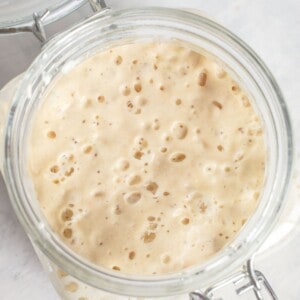
Sourdough Starter
Ingredients
Sourdough Starter:
- 5-7 Organic seedless green grapes
- 250 grams bread flour (9 ounces or approximately 2 cups)
- 250 ml lukewarm water (10 tablespoons or 9 fluid ounces)
Ingredients for Feeding Starter:
- 100 grams bread flour (3 ½ ounces or approximately ¾ cup + 1 tablespoon) approximately ¾ cup +1 tablespoon bread four
- 100 ml lukewarm water (7 tablespoons or 3 ½ fluid ounces)
Instructions
- Slice grapes in half and combine with flour and water. Tip into an airtight container and let sit at room temperature for three days. I've used a large mason jar or a covered mixing bowl. The mixtures will bubble and grow quite a bit so use a large enough container.
- After three days, remove the grapes and discard half of the mixture. “Feed” the remaining starter (100 grams starter) with 100 grams flour and 100 grams water. Stir until thoroughly combined. Leave in the same airtight container for another 24 hours.
- After this, the starter should be ready to use. The starter should be bubbly and about the consistency of pancake batter. If your mixture is not bubbly, that means the bacteria is not active, feed it again and let sit in container for a couple of days.
- If you’re planning on making sourdough bread regularly (like, once a week), then you should discard half of the starter and refeed the mixture every couple days. The mixture is best left at room temperature (except on very hot days--then place in fridge).
- If you are making bread less than once a week, you can store the starter in the fridge. Refeed it weekly if storing in the fridge. To use from the fridge, pull the starter out and let come to room temperature. Refeed and use once starter shows signs of activity.
- Remember to discard and refeed the starter after you make bread every time.
Notes
Nutrition
See our web story for this post.
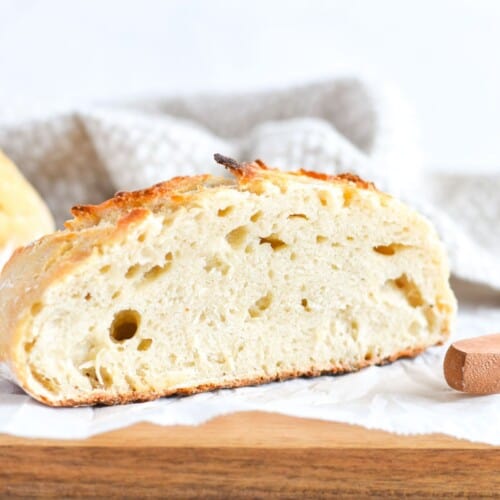






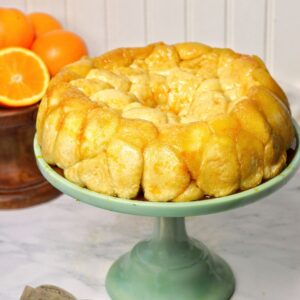
Theresa
Hi!
thank you for this recipe.
would you be able to tell me why we have to discard half of our starter?
thank you!
Theresa
In Fine Taste
Hi Theresa, the reason you discard half of the starter is because if you don't you will end up with an enormous amount of starter that continues to grow every time you feed it. For example, if you start with 100 grams of starter and then feed it 100 grams of water and 100 grams of flour, you now have 300 grams of starter. The next time you will feed the 300 grams of starer, 300 grams of flour and 300 grams of water, and you now have 900 grams of starter, you see where this is going?
So you discard half of it to keep a smaller amount of starter. If you find you need more starter, you can always feed the starter without discarding a portion of it to have more to share, use in recipes, etc. I hope that answers your question!
- Alyssa
Carolyn
I'm trying to make rye flour sourdough starter, I followed someone's directions (which didn't have enough detail for me, I'm new to sourdough) and it started to bubble, but then died. I like all the info given in your Paul Hollywood sourdough recipe, however, he suggests using bread flour, later saying to add rye flour for a stronger starter. I want to use all rye flour to make my starter, do I need to adjust something to make that work.
PS. I'm trying to follow a traditional Finnish recipe, because my grandparents were Finnish, and I am attempting to learn about traditional Finnish foods. thank you
In Fine Taste
Hi Carolyn! It sounds like the yeast is failing to establish early on. Sometimes whole grain flours can be a little finicky this way. The rye flour may convert the sugars faster than regular bread flour making it ferment too quickly.
I know you’d like to use all rye flour, but I would suggest using half rye, half all-purpose flour until you have a well established starter. Once it’s become stable and regular for a few weeks you can try feeding it all rye flour.
Other things you can try:
- When refeeding your starter feed it every 12 hours instead of every 24. Your starter may be eating through the starches too quickly and becoming acidic. Essentially, your starter is starving.
- Try using distilled water over tap water. Tap sometimes contained trace amounts of chlorine which can kill your microorganisms.
I hope you’re able to get your starter up and going! I think it’s super cool that you’re trying to learn about your Finnish heritage! —Alyssa